University Economics: Tariff and Quota Analysis for a Small Country
VerifiedAdded on 2023/02/01
|7
|790
|70
Homework Assignment
AI Summary
This assignment analyzes the effects of tariffs and quotas in a small country. It begins by illustrating the impact of an import tariff using a supply and demand diagram, explaining the changes in producer and consumer surplus, government revenue, and deadweight loss. The analysis distinguishes between normal and discriminatory tariffs. The assignment then examines tariff rate quotas (TRQ), illustrating the concept with a diagram and explaining the allocation of quota rent and tariff revenue. It highlights the benefits of TRQs for foreign producers. The document includes diagrams to visually represent the economic concepts and concludes with a list of references. The assignment provides a comprehensive overview of how tariffs and quotas influence international trade and the welfare of different economic actors.
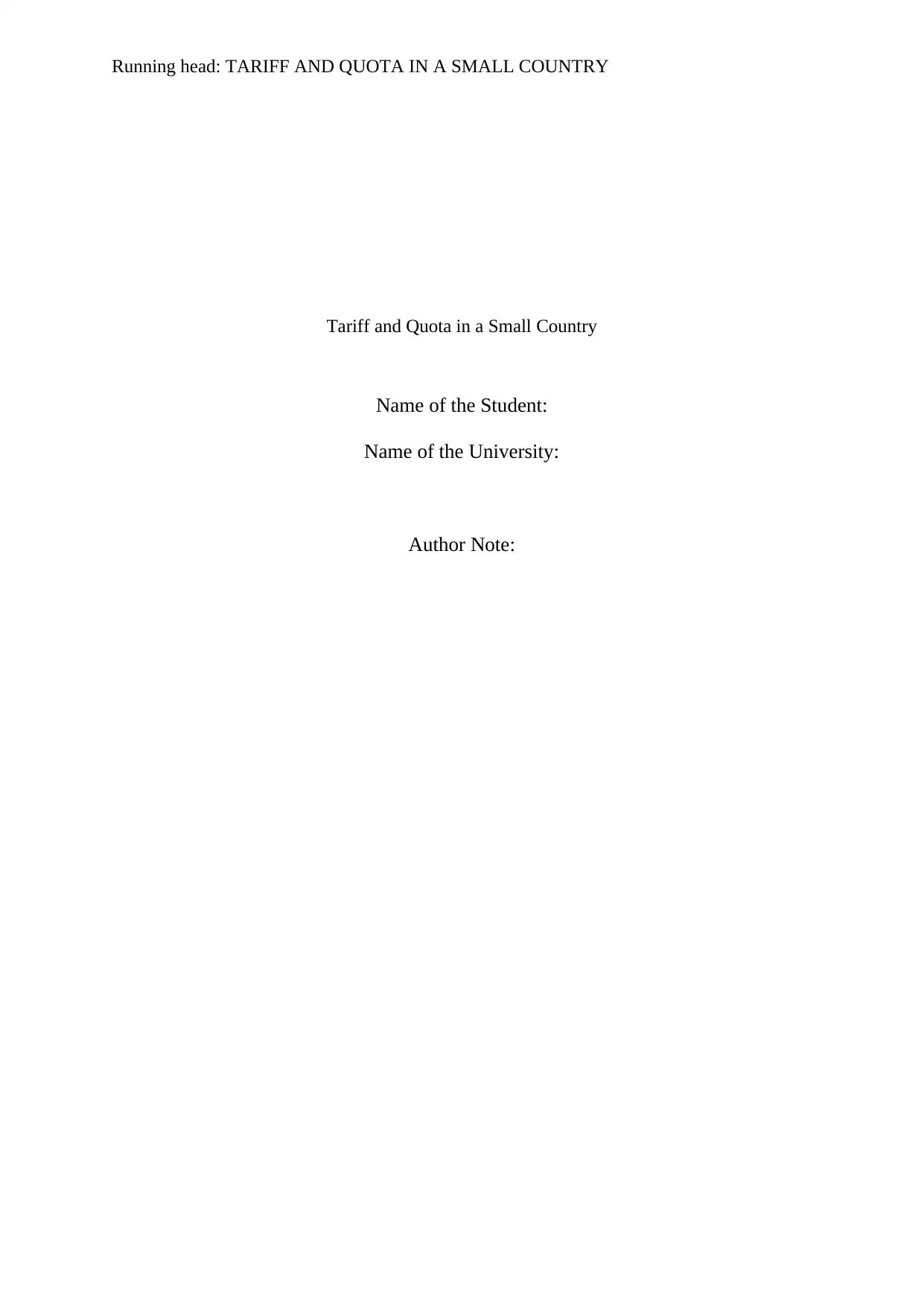
Running head: TARIFF AND QUOTA IN A SMALL COUNTRY
Tariff and Quota in a Small Country
Name of the Student:
Name of the University:
Author Note:
Tariff and Quota in a Small Country
Name of the Student:
Name of the University:
Author Note:
Paraphrase This Document
Need a fresh take? Get an instant paraphrase of this document with our AI Paraphraser
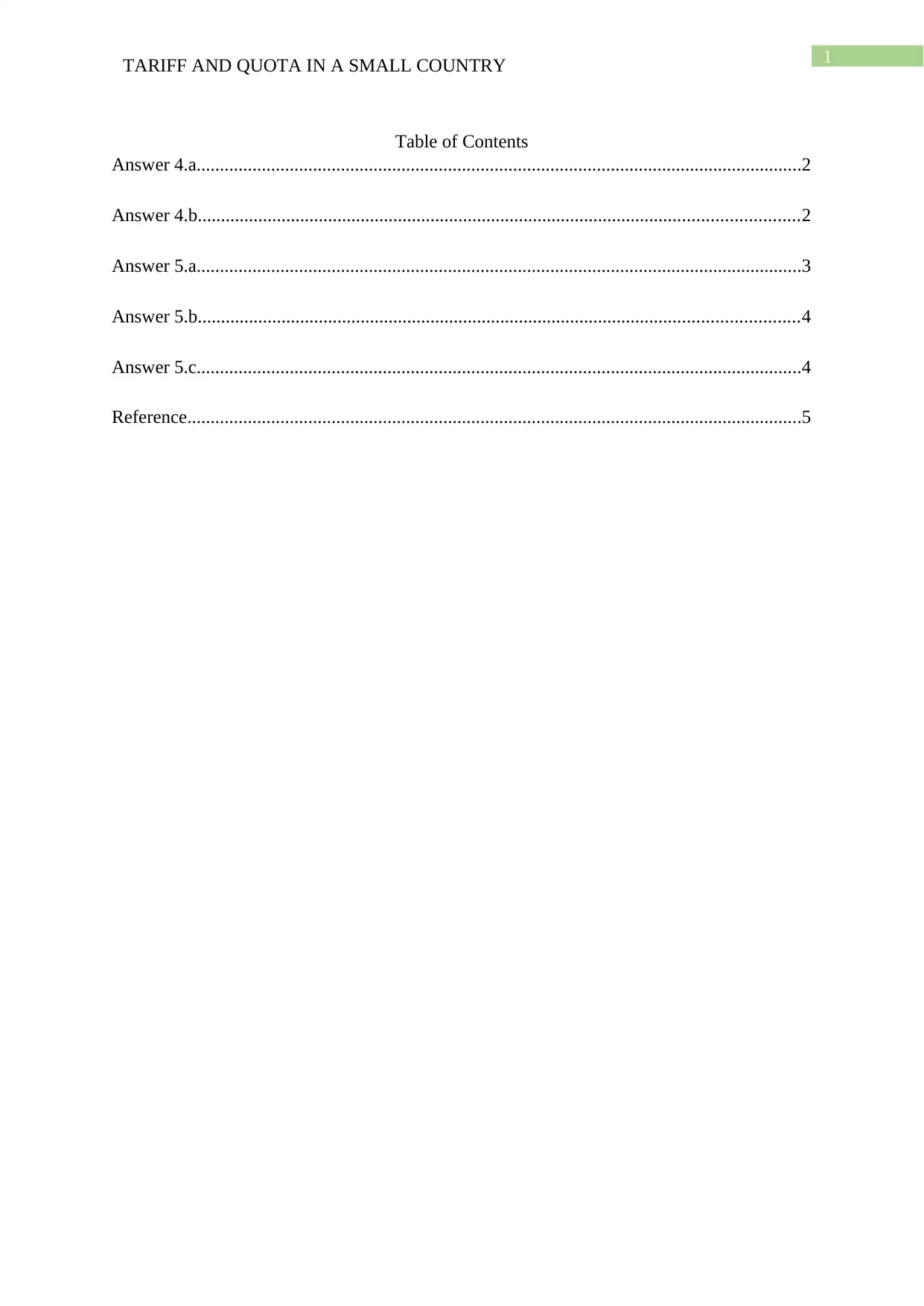
1TARIFF AND QUOTA IN A SMALL COUNTRY
Table of Contents
Answer 4.a..................................................................................................................................2
Answer 4.b.................................................................................................................................2
Answer 5.a..................................................................................................................................3
Answer 5.b.................................................................................................................................4
Answer 5.c..................................................................................................................................4
Reference....................................................................................................................................5
Table of Contents
Answer 4.a..................................................................................................................................2
Answer 4.b.................................................................................................................................2
Answer 5.a..................................................................................................................................3
Answer 5.b.................................................................................................................................4
Answer 5.c..................................................................................................................................4
Reference....................................................................................................................................5
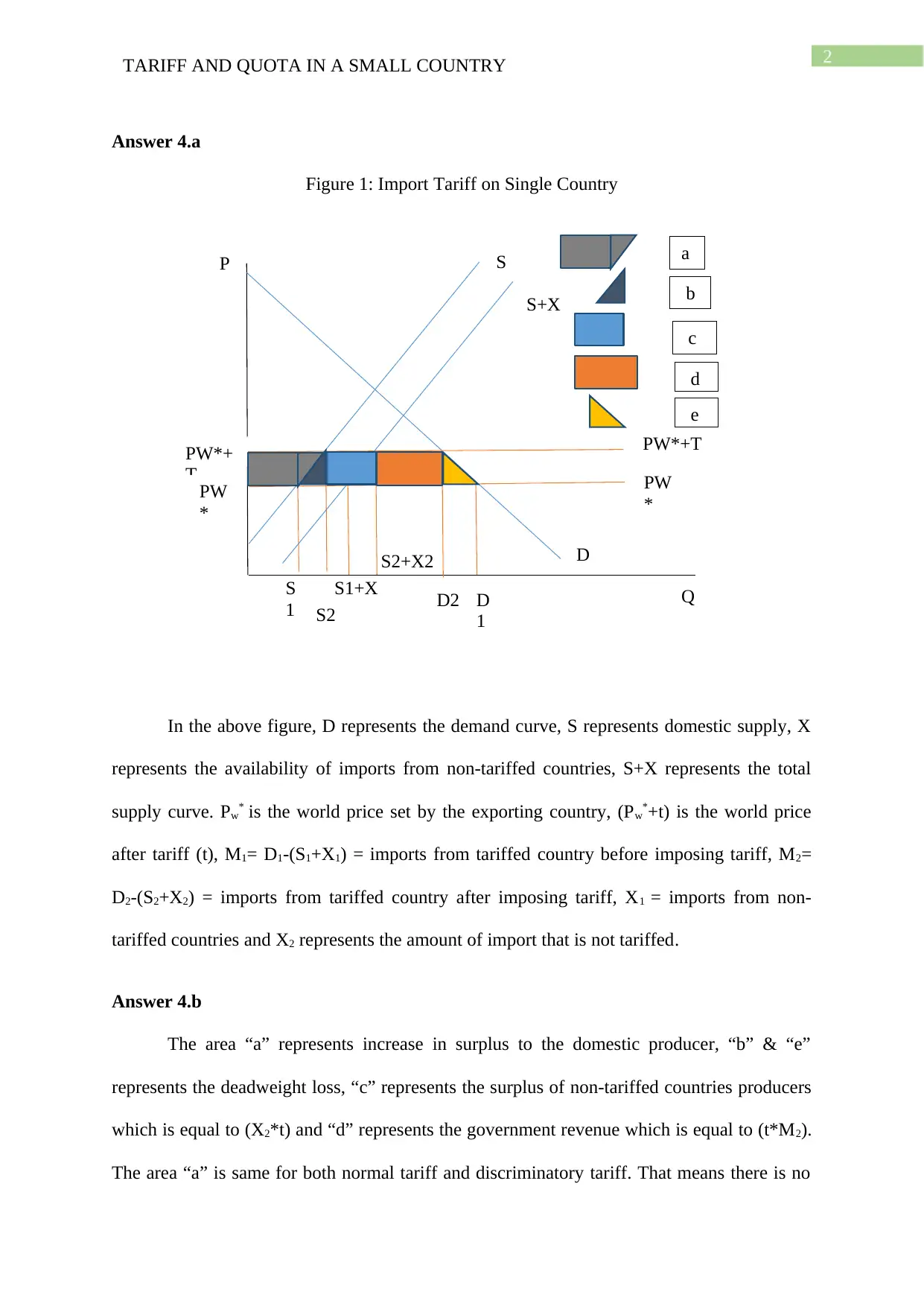
2TARIFF AND QUOTA IN A SMALL COUNTRY
PW*+
T PW
*
S2+X2
S1+X
1 D
1
D2
S2
S
1 Q
PW
*
PW*+T
P
D
S
S+X
a
b
c
d
e
Answer 4.a
Figure 1: Import Tariff on Single Country
In the above figure, D represents the demand curve, S represents domestic supply, X
represents the availability of imports from non-tariffed countries, S+X represents the total
supply curve. Pw* is the world price set by the exporting country, (Pw*+t) is the world price
after tariff (t), M1= D1-(S1+X1) = imports from tariffed country before imposing tariff, M2=
D2-(S2+X2) = imports from tariffed country after imposing tariff, X1 = imports from non-
tariffed countries and X2 represents the amount of import that is not tariffed.
Answer 4.b
The area “a” represents increase in surplus to the domestic producer, “b” & “e”
represents the deadweight loss, “c” represents the surplus of non-tariffed countries producers
which is equal to (X2*t) and “d” represents the government revenue which is equal to (t*M2).
The area “a” is same for both normal tariff and discriminatory tariff. That means there is no
PW*+
T PW
*
S2+X2
S1+X
1 D
1
D2
S2
S
1 Q
PW
*
PW*+T
P
D
S
S+X
a
b
c
d
e
Answer 4.a
Figure 1: Import Tariff on Single Country
In the above figure, D represents the demand curve, S represents domestic supply, X
represents the availability of imports from non-tariffed countries, S+X represents the total
supply curve. Pw* is the world price set by the exporting country, (Pw*+t) is the world price
after tariff (t), M1= D1-(S1+X1) = imports from tariffed country before imposing tariff, M2=
D2-(S2+X2) = imports from tariffed country after imposing tariff, X1 = imports from non-
tariffed countries and X2 represents the amount of import that is not tariffed.
Answer 4.b
The area “a” represents increase in surplus to the domestic producer, “b” & “e”
represents the deadweight loss, “c” represents the surplus of non-tariffed countries producers
which is equal to (X2*t) and “d” represents the government revenue which is equal to (t*M2).
The area “a” is same for both normal tariff and discriminatory tariff. That means there is no
⊘ This is a preview!⊘
Do you want full access?
Subscribe today to unlock all pages.

Trusted by 1+ million students worldwide
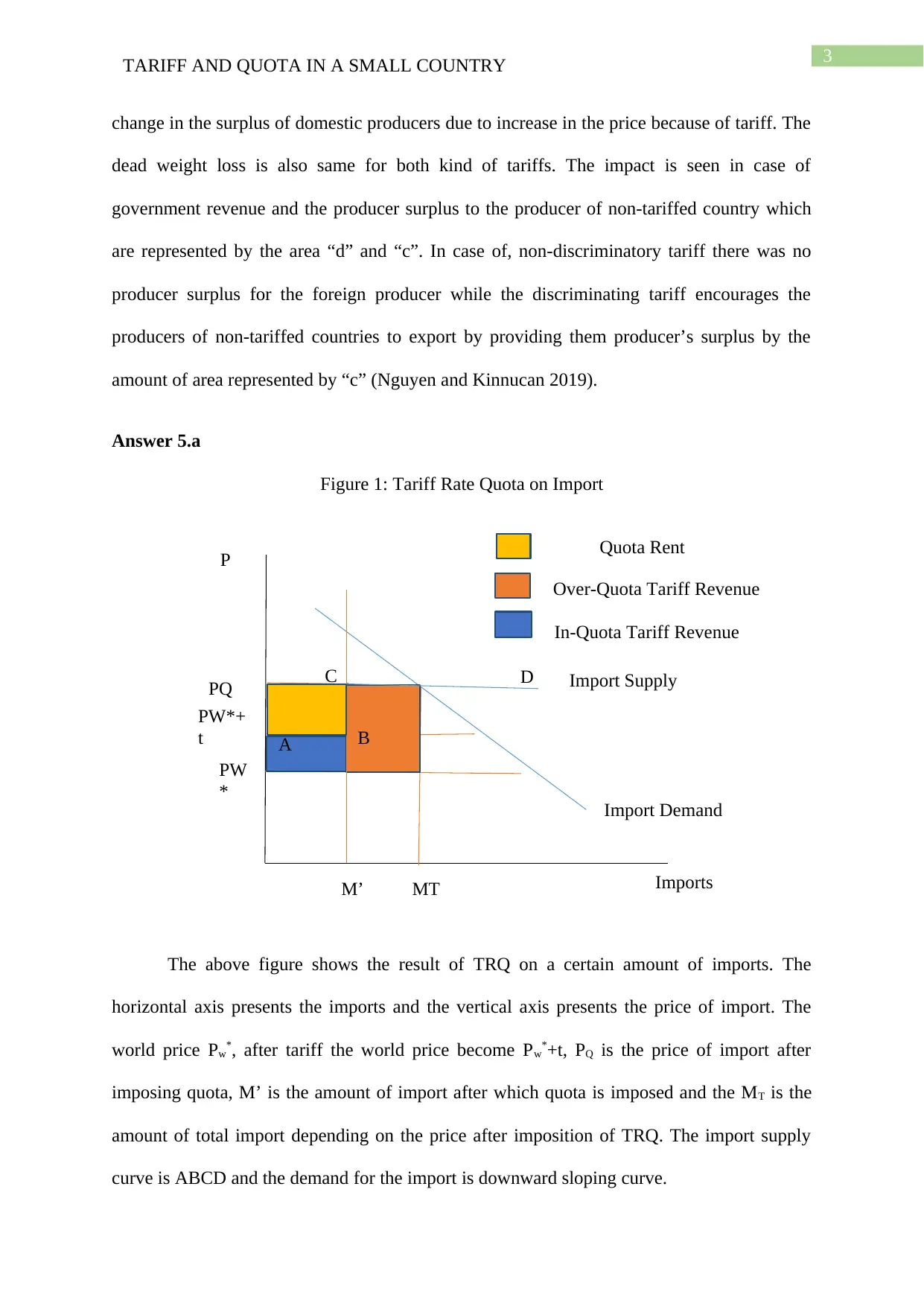
3TARIFF AND QUOTA IN A SMALL COUNTRY
PW
*
PW*+
t
PQ
P
Import Demand
C
Imports
Import Supply
BA
Quota Rent
In-Quota Tariff Revenue
Over-Quota Tariff Revenue
M’ MT
D
change in the surplus of domestic producers due to increase in the price because of tariff. The
dead weight loss is also same for both kind of tariffs. The impact is seen in case of
government revenue and the producer surplus to the producer of non-tariffed country which
are represented by the area “d” and “c”. In case of, non-discriminatory tariff there was no
producer surplus for the foreign producer while the discriminating tariff encourages the
producers of non-tariffed countries to export by providing them producer’s surplus by the
amount of area represented by “c” (Nguyen and Kinnucan 2019).
Answer 5.a
Figure 1: Tariff Rate Quota on Import
The above figure shows the result of TRQ on a certain amount of imports. The
horizontal axis presents the imports and the vertical axis presents the price of import. The
world price Pw*, after tariff the world price become Pw*+t, PQ is the price of import after
imposing quota, M’ is the amount of import after which quota is imposed and the MT is the
amount of total import depending on the price after imposition of TRQ. The import supply
curve is ABCD and the demand for the import is downward sloping curve.
PW
*
PW*+
t
PQ
P
Import Demand
C
Imports
Import Supply
BA
Quota Rent
In-Quota Tariff Revenue
Over-Quota Tariff Revenue
M’ MT
D
change in the surplus of domestic producers due to increase in the price because of tariff. The
dead weight loss is also same for both kind of tariffs. The impact is seen in case of
government revenue and the producer surplus to the producer of non-tariffed country which
are represented by the area “d” and “c”. In case of, non-discriminatory tariff there was no
producer surplus for the foreign producer while the discriminating tariff encourages the
producers of non-tariffed countries to export by providing them producer’s surplus by the
amount of area represented by “c” (Nguyen and Kinnucan 2019).
Answer 5.a
Figure 1: Tariff Rate Quota on Import
The above figure shows the result of TRQ on a certain amount of imports. The
horizontal axis presents the imports and the vertical axis presents the price of import. The
world price Pw*, after tariff the world price become Pw*+t, PQ is the price of import after
imposing quota, M’ is the amount of import after which quota is imposed and the MT is the
amount of total import depending on the price after imposition of TRQ. The import supply
curve is ABCD and the demand for the import is downward sloping curve.
Paraphrase This Document
Need a fresh take? Get an instant paraphrase of this document with our AI Paraphraser
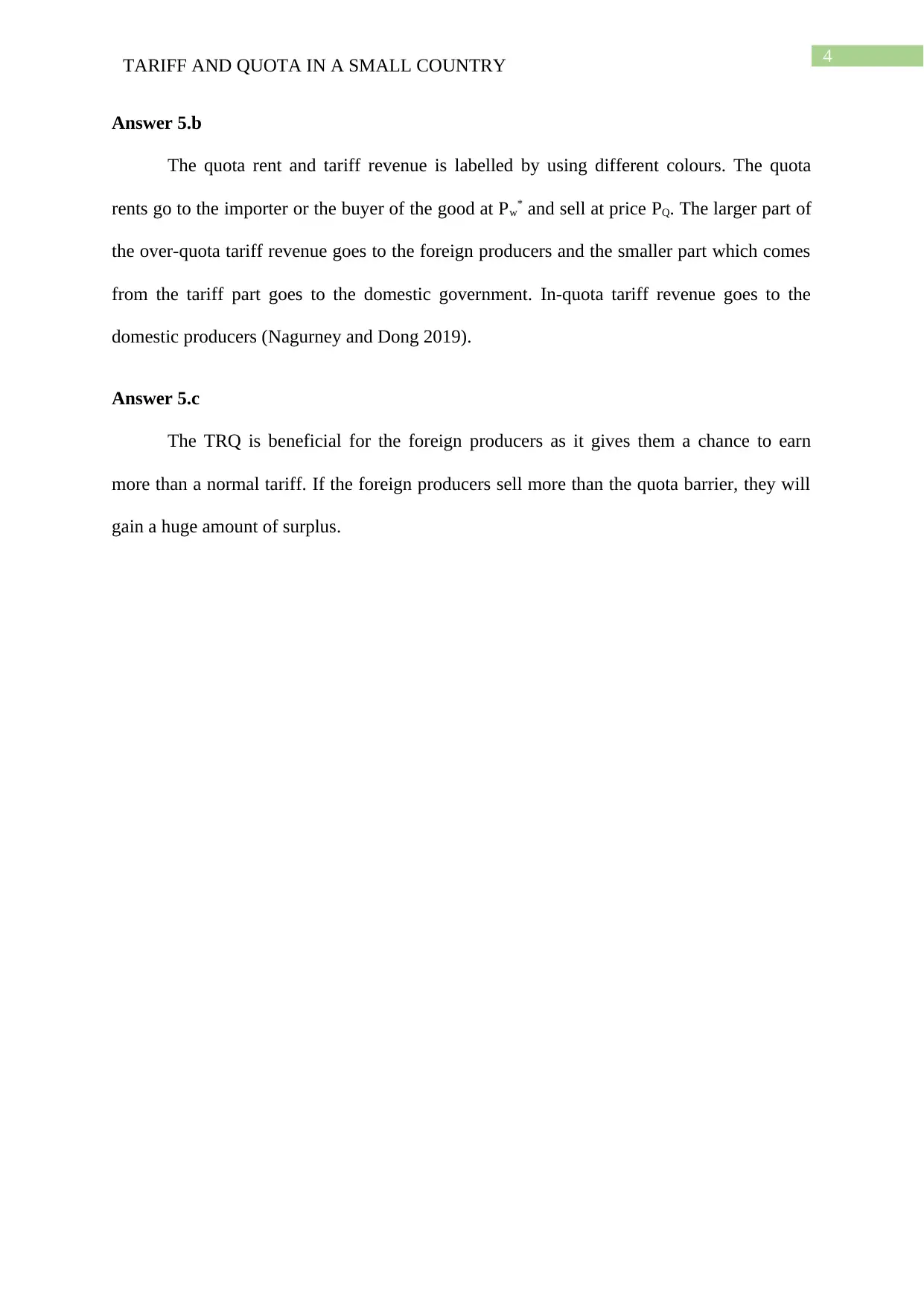
4TARIFF AND QUOTA IN A SMALL COUNTRY
Answer 5.b
The quota rent and tariff revenue is labelled by using different colours. The quota
rents go to the importer or the buyer of the good at Pw* and sell at price PQ. The larger part of
the over-quota tariff revenue goes to the foreign producers and the smaller part which comes
from the tariff part goes to the domestic government. In-quota tariff revenue goes to the
domestic producers (Nagurney and Dong 2019).
Answer 5.c
The TRQ is beneficial for the foreign producers as it gives them a chance to earn
more than a normal tariff. If the foreign producers sell more than the quota barrier, they will
gain a huge amount of surplus.
Answer 5.b
The quota rent and tariff revenue is labelled by using different colours. The quota
rents go to the importer or the buyer of the good at Pw* and sell at price PQ. The larger part of
the over-quota tariff revenue goes to the foreign producers and the smaller part which comes
from the tariff part goes to the domestic government. In-quota tariff revenue goes to the
domestic producers (Nagurney and Dong 2019).
Answer 5.c
The TRQ is beneficial for the foreign producers as it gives them a chance to earn
more than a normal tariff. If the foreign producers sell more than the quota barrier, they will
gain a huge amount of surplus.
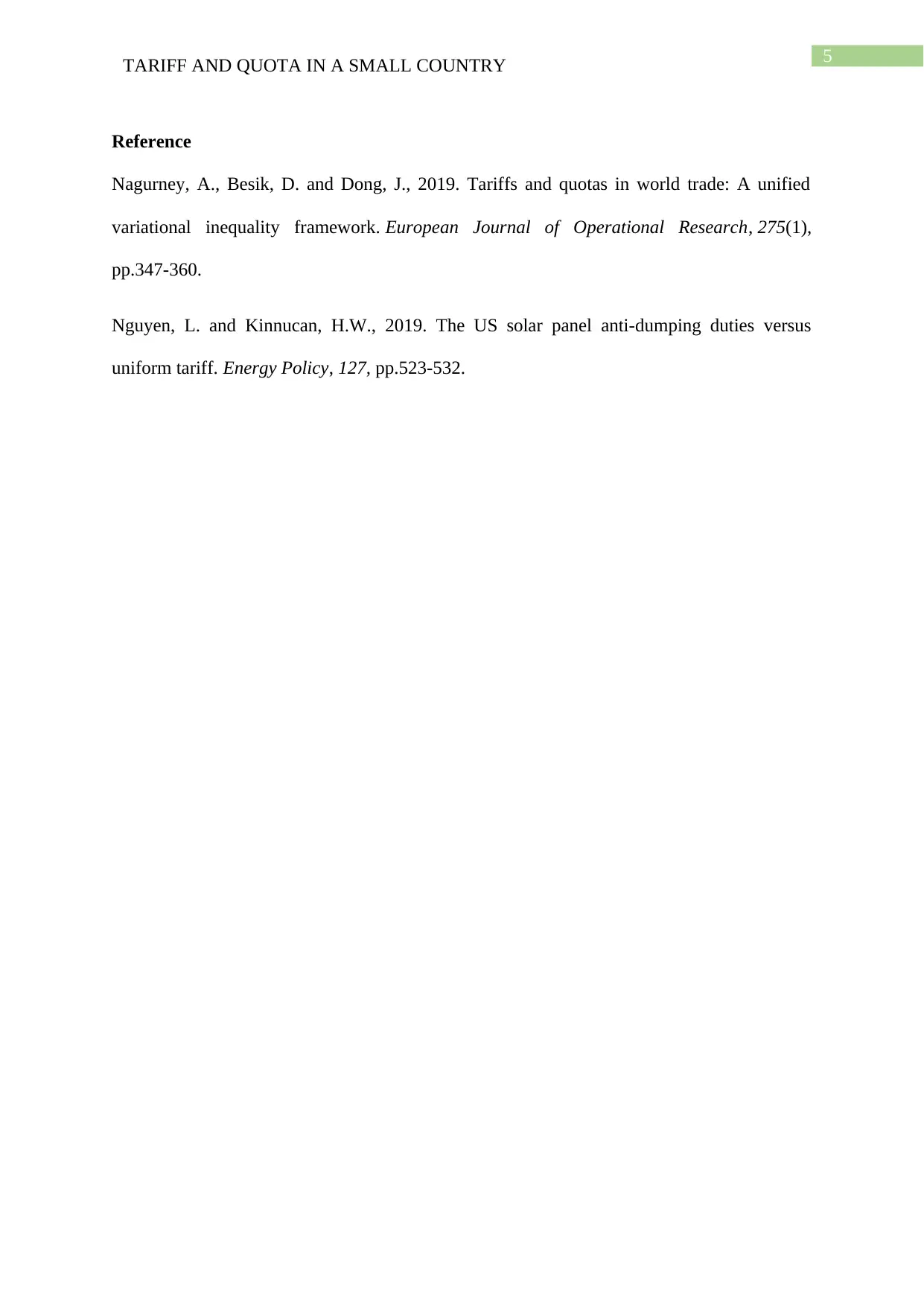
5TARIFF AND QUOTA IN A SMALL COUNTRY
Reference
Nagurney, A., Besik, D. and Dong, J., 2019. Tariffs and quotas in world trade: A unified
variational inequality framework. European Journal of Operational Research, 275(1),
pp.347-360.
Nguyen, L. and Kinnucan, H.W., 2019. The US solar panel anti-dumping duties versus
uniform tariff. Energy Policy, 127, pp.523-532.
Reference
Nagurney, A., Besik, D. and Dong, J., 2019. Tariffs and quotas in world trade: A unified
variational inequality framework. European Journal of Operational Research, 275(1),
pp.347-360.
Nguyen, L. and Kinnucan, H.W., 2019. The US solar panel anti-dumping duties versus
uniform tariff. Energy Policy, 127, pp.523-532.
⊘ This is a preview!⊘
Do you want full access?
Subscribe today to unlock all pages.

Trusted by 1+ million students worldwide

6TARIFF AND QUOTA IN A SMALL COUNTRY
1 out of 7
Related Documents
Your All-in-One AI-Powered Toolkit for Academic Success.
+13062052269
info@desklib.com
Available 24*7 on WhatsApp / Email
![[object Object]](/_next/static/media/star-bottom.7253800d.svg)
Unlock your academic potential
Copyright © 2020–2025 A2Z Services. All Rights Reserved. Developed and managed by ZUCOL.




